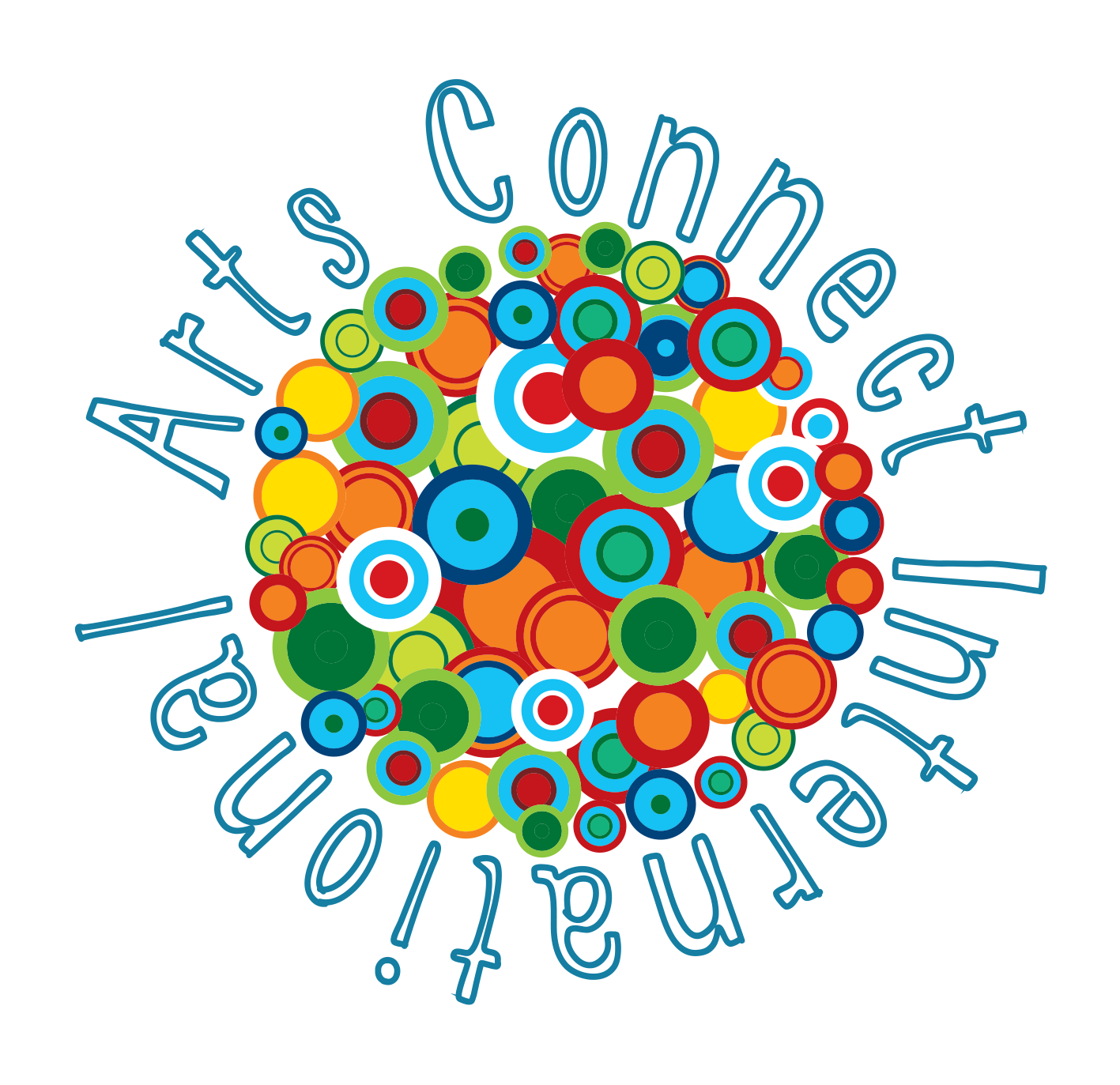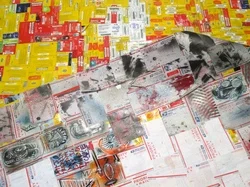ACI Artist Leader Basil Kincaid
International Residency: Accra, Ghana
National Residency: St.Louis, USA
The first month as an Artist-in-Residence with Arts Connect International was a whirlwind, I felt the fire inside rage as it began growing to new heights. The year prior to beginning the residency I was teaching middle school art in New Orleans to a group of really amazing and dynamic 8th graders. It was extremely interesting to interact with them on a daily basis, reminding me of what I was like as an 8th grader… the energy, the excitement, the confusion, and the hormones, all of which commingle into this cocktail of emotions and expressions. All I wanted was to show and share with them various outlets of encapsulating their experiences visually. I love my kids and miss them, even now, as I pen this note to history. In the midst of all this love and excitement rested the other side of this double-edged experience.
The school where I was working follows a growing model of nearly military strictness in which children are punished often for very minor offenses. For example, if a child drops their pencil they must seek permission to pick it up; and if they don’t, they can be punished. Students are walked by the teacher from one class to the next and awarded not even the slightest freedoms. During the walks from class to class students are instructed to remain silent and in single file, if a student speaks or steps out of line they can be punished at the discretion of the teacher. This model is one that in my experience; and through my observations, is terrible for the children that it serves. This school follows what is called a “no excuses model" which constricts expression and restricts the freedom of the student body. The school resembles more closely a prison than any other institution of learning I have ever seen or experienced. In an environment where children are constantly punished for such menial things as stepping out of line, or picking up a dropped pencil without permission, it is difficult to imagine that same child with the confidence required to share original ideas. How does one inspire creativity when the only praise she hears comes from participating well in call and response style activities that are dressed up as learning?
In many ways I felt like a double agent, trying to share glimpses of freedom and light in a dark and confined world. There were other select teachers that did their best to break the mold of this model as well. As much as I couldn’t take living in this environment of oppression, it still hurt to leave because I saw so many eager and talented 7th graders that wanted to take my class, and deserved that access to art. I knew that in leaving this school the art program would discontinue.
I knew that I had to leave, and I know that many teachers will continue to. However, I left with a deep rooted conviction that something must be done. I felt compelled to take things into my own hands, and here is when serendipity of the universe comes into play. I went home to St. Louis with an idea in mind that I wanted to do some sort of free camp before I began the residency, rooted in my home town; before I went abroad to Accra, Ghana, the point of departure for many of the enslaved Africans that were imported to the United States. I had this vision or running an art camp for kids, operated on our own terms, operated outside of oppressive structures and guided by love. At that moment I needed to prove; at least to myself, that black kids could be taught in a free environment of love and trust, rather than one of distrust and chastisement. I wanted to work with a staff that was reflective of the students that would participate, and I wanted a student-teacher ratio of no greater than 3 to 1. There I was in St. Louis, sitting with a friend and collaborator Eric ‘Prospect’ White, when our friend Pacia Anderson walks in and asks if we want to collaborate on an art show and festival for children.
From there it was like a lightning strike, it felt like she was reading my mind, we even had the same places, venues, and concepts in mind. We sat there for this impromptu meeting and sketched out the concept for a camp that would become Street Reach. The rest of the team was already coming together behind the scenes outside of my knowledge. This all happened within 48 hours of arriving in the city. We spent the next three weeks planning and gathering participants for the camp, and began disseminating information and flyers for the capstone festival to take place at the end of the camp.
Street Reach was a great success. Kids were showing up earlier and earlier everyday and wanting to leave later and later. I could go on at length about the camp, but I feel like their smiles tell the story better than I ever could.
It was our goal to expose the children to different parts of the city and have them see the world around them through the lens of art. We did a day at the Jewel Box, a large green house with accompanying open air gardens where we drew plants with pastels. A local artist, Peat Wolleager; who I ended up continuing a working relationship with after the camp, opened his studio and gallery to the children to talk to them about life as a working artist and to demonstrate the process of going from making work to presenting it and selling it to the public.
It was also our goal to expose the children to a number of different art forms. We painted, drew, collaged, wrote poetry and stories in addition to working with a variety of different materials. We emphasized art as a part of healthy living and along with this idea made sure that all of our snacks for the club were healthy and nutritious. We had fresh fruit smoothies every morning and healthy snacks throughout the day. We also were very interested in exposing the children to art as a way to boost their confidence with the hopes that they would carry what they learned, and the new practices with them into the future.
I feel that we met all of these goals as I still have parents calling me telling me about how their sons and daughters have an invigorated passion for art and want to make and share their art all the time now. They tell me of how the children are making more art than ever before and the parents are excited to see this development within their children. In contrast to the no excuses model that we spoke of before, we treated the children with love and respect and we didn’t have a single behavior problem. I remember telling my last boss that I felt you could achieve the same; or stronger, results from a system of trust, responsibility and love. This camp proved my hypothesis true. We got better results coupled with consistent performance and participation. Additionally, I feel that the children felt truly inspired and empowered by the camp.
This camp was so inspiring and empowering for me personally and I know that the kids had a wonderful experience as they expressed how eager they are to return. We culminated the camp with a day-long community art fair and festival that was open to the community and surrounding neighborhoods. A number of local artists and musicians came out to share their talents with the children in the community. Each artist had a station where they were doing demonstrations of their gift (work), teaching and sharing with youth, and the wider community. It was a truly spectacular event and I had to remove myself at one point to shed a few tears of joy.
After the camp I was blessed enough to find studio space with two really amazing mid-career artists, Peat Wolleager and Cbabi Bayoc. Both artists shared wisdom that was invaluable and that helps me to this day. I spent extensive time processing and sharing ideas with them, and they coached me with online sales and marketing and concept development. Further, we spent time exploring ideas and digging deeper into artistic experiments in our own individual work. It was a profound time in my life and career that started to give me confidence as a professional artist by being in their company. To be able to talk and share like peers with older more experienced artists was incredibly empowering to me. Despite the fact that they are far ahead of me in their development as artists they made me feel like an equal. This time was really amazing, and having my own space in St. Louis allowed me to stretch out creatively.
That month was filled with direct action and meetings in response to the murder of Mike Brown. At the same time I was working to make and sell as much art as possible in preparation for my trip to Ghana for the extension of the Reclamation Project, whose roots, like my own, are based in St. Louis. It felt more like a long week or a day than a month. It was so worth it to see how the universe responds to genuine and passionate efforts. Perhaps most importantly, I learned to relinquish worry and trust. Not in myself, but in the network of the universe, which is greater than its constituent parts.
All is well looking forward to my time in Boston for training, then my departure for Ghana at the end of October.





